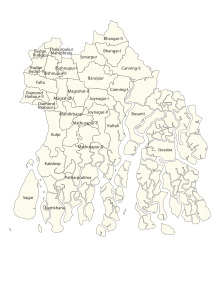Population
As per 2011 Census of India, Canning I CD block had a total population of 304,724, of which 181,508 were rural and 123,216 were urban. There were 155,126 (51%) males and 149,598 (49%) females. Population below 6 years was 44,344. Scheduled Castes numbered 144,906 (47.55%) and Scheduled Tribes numbered 3,710 (1.22%). [10]
As per 2001 Census of India, Canning I CD block had a total population of 244,354, out of which 125,216 were males and 119,138 were females. Canning I CD block registered a population growth of 24.48 per cent during the 1991-2001 decade. Decadal growth for South 24 Parganas district was 20.89 per cent. Decadal growth in West Bengal was 17.84 per cent. Scheduled Castes at 126,485 formed about one-half the population. Scheduled Tribes numbered 6,731. [11] [12] [13]
Census Towns in Canning I CD block (2011 census figures in brackets): Kalaria (10,075), Gaur Daha (5,260), Banshra (29,521), Rajapur (9,754), Taldi (12,459), Bayarsingh (8,346), Matla (31,920) and Dighirpar (15,881). [10]
Large villages (with 4,000+ population) in Canning I CD block (2011 census figures in brackets): Khas Kumarkhali (7,227), Sibnagar (5,667), Daria (4,900), Bhaleya (5,858), Hatpukhuria (4,629), Devis Abad (8,128), Dharmatala (5,003), Duttababur Abad (6,095), Gopalpur (4,958), Hero Bhanga (7,339), Uttar Redokhali (5,006), Maukhali (4,164), Uttar Angad Baria (5,141), Kumarsa Chak (7,334), Banibadabede Khali (4,930), Budh Khali (8,908), Gola Bari (4,896) and Modhu Khali (5,546). [10]
Other villages in Canning I CD block include (2011 census figures in brackets): Nikarighata (3,419), Tangrakhali (1,221). [10]
Literacy
As per the 2011 census, the total number of literates in Canning I CD block was 184,241 (70.76% of the population over 6 years) out of which males numbered 103,611 (78.31% of the male population over 6 years) and females numbered 80,630 (62.95% of the female population over 6 years). The gender disparity (the difference between female and male literacy rates) was 15.36%. [10]
As per 2011 Census of India, literacy in South 24 Parganas district was 77.51 [14] Literacy in West Bengal was 77.08% in 2011. [15] Literacy in India in 2011 was 74.04%. [15]
As per 2001 Census of India, Canning I CD block had a total literacy of 60.49 per cent for the 6+ age group. While male literacy was 72.56 per cent female literacy was 47.79 per cent. South 24 Parganas district had a total literacy of 69.45 per cent, male literacy being 79.19 per cent and female literacy being 59.01 per cent. [11]
See also – List of West Bengal districts ranked by literacy rate





















